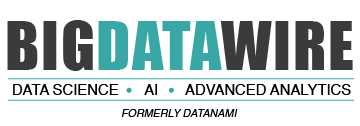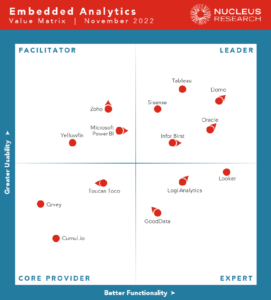

(ZinetroN/Shutterstock)
Data makes the world go round; you won’t get much argument from us on that. But if there’s one thing better than having the right piece of information, it’s having it at the right time. And that, in a nutshell, is why embedded analytics and AI will be so critical to big data’s future.
Despite the progress we’ve made since the big data revolution began, access to data and data tools is still largely restricted to a select few. In many companies, it’s the BI dashboard-wielding business analysts who ask tough questions and the data scientists who really dig in to spot patterns and anomalies that can be monetized, often through machine learning and AI-powered automation.
But that leaves the bulk of the regular works out of the data loop. While the customer service representatives, bus drivers, and teachers may not have the SQL skills of a Tableau or PowerBI power user, they do have ample opportunities to impact the business through data. But currently they’re not given the opportunity because they don’t have the right tools.
One of the folks who is dedicated to closing this information access gap is Amir Orad, the CEO of Sisense, which is one of the top five providers of embedded analytics solutions, according to Nucleus Research.
“Gartner shows 80% of all employees don’t leverage BI or insights because it takes skills and learning. You have to go to another system and log in. It’s too much,” Orad tells Datanami. “I’m a big believer that insight will be embedded in everyday tools people use, and stop being as much as possible a side tool to come to and ask ridiculous questions, and that will truly open the other 80%.”
Nucleus Research Senior Analyst Alexander Wurm, author of the recently released Embedded Analytics Technology Value Matrix 2022 report, would likely agree with Orad’s assessment.
“The embedded analytics market has taken off in parallel as organizations look to empower internal departments with analytics embedded in the applications they already use, and many consumer-facing businesses are embedding analytic capabilities to differentiate their products and elevate their customer experience,” Wurm writes in the report, which you can access here.
“To support this broadening adoption, embedded analytics providers are investing in complete cloud services to enable data discovery, modeling, reporting, and visualization creation within external applications and compete to deliver highly usable services to empower analysts, creators, and end-consumers,” he continues.
Several different types of companies are turning to embedded analytics. Tech firms and ISVs are looking to embedded analytics to “elevate end-user experience and unlock additional revenue,” Wurm writes, while less technical teams have also embraced embedded analytics as a way to enable data democratization.
“This is crucial for business-level users who may not be familiar with statistical methods but can be taught to turn data into relevant insights with the correct tools,” he writes.
The broader BI and visualization tool market is turning to machine learning and AI, which is a trend that IT analyst groups like Gartner have been documenting for years. Nucleus says the embedded analytics market is also adopting ML and AI, as well as natural language query (NLQ) and natural language generation (NLG) tools. Industry leaders like Sisense, Domo, Tableau, Oracle, and Infor Birst are leading the way with NLG and NLQ capabilites, and the rest of the market is about 18 months behind, Wurm writes.
Prepped for Growth
Sisense has turned a specialty in embedded analytics into a business with annual recurring revenue of $150 million, around 600 employees, and more than 2,000 customers, including household names like Expedia, Motorola, and Nasdaq. Orad, who joined the company in 2014, has guided the company’s growth in the embedded analytics space.
There are two secrets to success in embedded analytics, Orad says. (“They are not secrets,” he confesses, “but just bloody hard.”)
First, if your analytics are embedded in someone else’s product, it’s not enough to have a nice dashboard that appears on the screen. “You have to be embedded in the security layer, you have to be embedded in their development cycle, the software lifecycle process,” Orad says. “You have to be embedded in their cloud architecture, leveraging the same cloud multi-tenancy. That’s very difficult.”
The second and arguably tougher secret to success is displaying the right piece of information within the context of the moment and the individual. The slick animated 3D graph you made to impress your data-loving boss? That likely won’t cut it in the real world, where conveying accurate and actionable information to blue-collar workers is the name of the game.
“The people that use Sisense are not data professionals. They are teachers, nurses, doctors, marketing professionals, truck drivers, QA managers,” Orad says. “They know [poppycock] about data analysis. They know their domain really well, but they don’t know what is a SQL statement and a big lookup left join something. They don’t care.”
Netflix movie recommendations, for example, are so slick that you almost don’t even realize they’re there. But sure enough, there is a lot of data and machine learning behind the scenes working to pick out the perfect movie for you (or at least the best the algorithm could come up with).
Google Maps is another example of embedded analytics hiding in plain sight. In the not-to-distant past, people actually bought external devices to track the flow of traffic. But since traffic flow is one of the layers offered on Google Maps, there’s no longer a need to for another app (let alone another device).
“I’m a big believer that insight will be embedded in everyday tools people use,” Orad says, “and stop being as much as possible a side tool to come to and ask ridiculous questions, and that will truly open the other 80%.”
Embedding for Enterprise
Sisense recently shipped two new pieces of functionality that will made embedded analytics easier to work with.
First, Sisense now integrates with Git, enabling the development work involved with integrating Sisense with a given application to be tracked using the same version control repository that the rest of the computing world users.
While embedded analytics present an easy-to-use face to the outside world, inside there is a lot of hard work involved, as Orad alluded to above. The integration with Git helps ensure that Sisense development can proceed in lockstep with the rest of the IT world.
“We could have developed and offered our own version control tool,” Orad says. “Some people have tried to do that in our space. But if I’m not part of someone else version control, it doesn’t help, because I’m part of a bigger lifecycle than just me.”
The second new feature is full multi-tenancy, which help large Sisense customers by allowing them to deliver much more tailored embedded analytics experiences without overburdening their IT department or giving up control.
“What does it mean? With Expedia, for 100,000 customers, it can turn on and off every feature–look and feel, data modeling, all the trails, alerts, AI–everything is controlled at the granular level,” Orad says. “You don’t need it if you have three departments in a company. But in our case, there were many one-to-many relationships. It’s really valuable.”
Previously, if Sisense had 100,000 end-users, it would have required more development and management work to house separate product for each user or group of users. With multi-tenancy, it’s much easier to tailor the experience to particular groups or individuals.
“It sounds boring. But for people with business applications, it’s a really big deal,” Orad says. “It goes to the data, the modeling, the security, the look and feel, and the features. And it’s important when you get to this scale of the 80% unserved market.”
With billions of potential customers of embedded analytics apps on the horizon, it’s clear that the old patterns of BI won’t hold. A new paradigm is needed to unleash the potential of data analytics and AI upon the masses. Those who figure out how to scale the data insight and creativity without breaking security and IT rules seemed poised for success.
Related Items:
Why Embedded Analytics Are the Foundation of a Successful Application
Best Practices for Building a Data Product with Embedded Analytics
Embedded Analytics Sector Consolidates
July 3, 2025
- FutureHouse Launches AI Platform to Accelerate Scientific Discovery
- KIOXIA AiSAQ Software Advances AI RAG with New Version of Vector Search Library
- NIH Highlights AI and Advanced Computing in New Data Science Strategic Plan
- UChicago Data Science Alum Transforms Baseball Passion into Career with Seattle Mariners
July 2, 2025
- Bright Data Launches AI Suite to Power Real-Time Web Access for Autonomous Agents
- Gartner Finds 45% of Organizations with High AI Maturity Sustain AI Projects for at Least 3 Years
- UF Highlights Role of Academic Data in Overcoming AI’s Looming Data Shortage
July 1, 2025
- Nexdata Presents Real-World Scalable AI Training Data Solutions at CVPR 2025
- IBM and DBmaestro Expand Partnership to Deliver Enterprise-Grade Database DevOps and Observability
- John Snow Labs Debuts Martlet.ai to Advance Compliance and Efficiency in HCC Coding
- HighByte Releases Industrial MCP Server for Agentic AI
- Qlik Releases Trust Score for AI in Qlik Talend Cloud
- Dresner Advisory Publishes 2025 Wisdom of Crowds Enterprise Performance Management Market Study
- Precisely Accelerates Location-Aware AI with Model Context Protocol
- MongoDB Announces Commitment to Achieve FedRAMP High and Impact Level 5 Authorizations
June 30, 2025
- Campfire Raises $35 Million Series A Led by Accel to Build the Next-Generation AI-Driven ERP
- Intel Xeon 6 Slashes Power Consumption for Nokia Core Network Customers
- Equal Opportunity Ventures Leads Investment in Manta AI to Redefine the Future of Data Science
- Tracer Protect for ChatGPT to Combat Rising Enterprise Brand Threats from AI Chatbots
June 27, 2025
- Inside the Chargeback System That Made Harvard’s Storage Sustainable
- What Are Reasoning Models and Why You Should Care
- Databricks Takes Top Spot in Gartner DSML Platform Report
- LinkedIn Introduces Northguard, Its Replacement for Kafka
- Change to Apache Iceberg Could Streamline Queries, Open Data
- Agentic AI Orchestration Layer Should be Independent, Dataiku CEO Says
- Why Snowflake Bought Crunchy Data
- Fine-Tuning LLM Performance: How Knowledge Graphs Can Help Avoid Missteps
- Top-Down or Bottom-Up Data Model Design: Which is Best?
- The Evolution of Time-Series Models: AI Leading a New Forecasting Era
- More Features…
- Mathematica Helps Crack Zodiac Killer’s Code
- ‘The Relational Model Always Wins,’ RelationalAI CEO Says
- Confluent Says ‘Au Revoir’ to Zookeeper with Launch of Confluent Platform 8.0
- DuckLake Makes a Splash in the Lakehouse Stack – But Can It Break Through?
- Solidigm Celebrates World’s Largest SSD with ‘122 Day’
- The Top Five Data Labeling Firms According to Everest Group
- Supabase’s $200M Raise Signals Big Ambitions
- Toloka Expands Data Labeling Service
- With $17M in Funding, DataBahn Pushes AI Agents to Reinvent the Enterprise Data Pipeline
- Databricks Is Making a Long-Term Play to Fix AI’s Biggest Constraint
- More News In Brief…
- Astronomer Unveils New Capabilities in Astro to Streamline Enterprise Data Orchestration
- Databricks Unveils Databricks One: A New Way to Bring AI to Every Corner of the Business
- Seagate Unveils IronWolf Pro 24TB Hard Drive for SMBs and Enterprises
- Gartner Predicts 40% of Generative AI Solutions Will Be Multimodal By 2027
- BigBear.ai And Palantir Announce Strategic Partnership
- Astronomer Introduces Astro Observe to Provide Unified Full-Stack Data Orchestration and Observability
- Databricks Donates Declarative Pipelines to Apache Spark Open Source Project
- Deloitte Survey Finds AI Use and Tech Investments Top Priorities for Private Companies in 2024
- Code.org, in Partnership with Amazon, Launches New AI Curriculum for Grades 8-12
- Databricks Announces Data Intelligence Platform for Communications
- More This Just In…




























